B2B commerce in a world of B2C expectations


This month, Tina Nelson and I hosted a webinar helping B2B businesses understand and plan for the changes that are coming as market expectations are shifting. For those of you who would like to see this in video form, feel free to watch on-demand via the link below. For those of you who prefer the written word, read on.
B2B Commerce in a World of B2C Expectations
(don’t worry – you can set the playback speed to 2x… we all do it 😉)
The changing landscape
The B2B landscape has been changing rapidly – but before you say “yes, I know, a pandemic…”, let’s talk about a monumental shift that has been happening since before anyone had said “COVID-19”.
Generational shift has an increasingly significant impact on B2B businesses. More than ever, the Millennial generation has taken control of B2B buying decisions and are changing the expectations for suppliers and manufacturers. Millennials now make up more than 50% of B2B buyers and 44% of Millennials who are involved in the buying process are sole decision makers. This shift in team composition has ripple effects throughout the business, but it is felt perhaps most keenly in the rising expectations of digital experiences.

With digital interactions being table stakes for this generation, B2B businesses are having to figure out how to accommodate increased demands for easy and useful digital experiences.
Personalization is one of the critical components of these new digital expectations. McKinsey identified that companies who excel at personalization generate 40% more revenue. In 2021, 72% of ecommerce users would ONLY engage with personalized messaging. In B2B relationships particularly, buyers expect to be treated as a known customer. Personalized pricing, order history and personalized credit terms are all examples of personalization B2B suppliers have been doing for years. Additional offerings like customer dashboards, personalized product recommendations, curated/personalized re-order lists, specific home pages per customer type, search results influenced by order history, and prioritized categories based on potential personalization that takes this to the next level.
Adapt to build trust in a digital world
Despite the focus on digital experiences, relationships of trust are still the driving force of B2B business. In the same way B2C businesses try to instill trust via brand, B2B businesses need to build trust through meaningful customer interactions. This is well known among practitioners, but it’s always good to be reminded of the basics. Here are some ingredients to building trust with B2B customers (from Katie Martell):
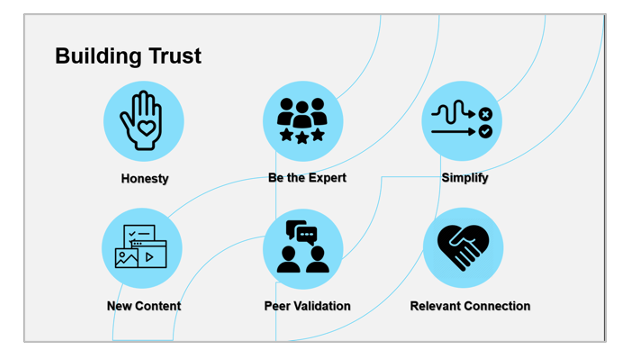
This approach to building trust as the primary priority in B2B does not actually conflict with digital. In fact, much like your branch or in-store experience contributes to your customers’ sense of trust, so too does your digital experience. For instance, information overload is one of the most prevalent problems in business today. Consider these:
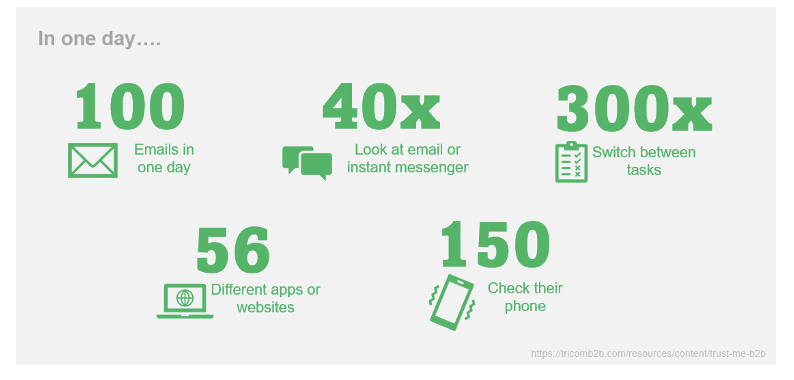
Now imagine your team takes a proactive approach to reducing the interactions required to get to the key information for making purchasing decisions. Do you think your customers trust you more? Are they likely to come to you with more of their questions or to determine difficult requirements?
In the same vein, the shift to more digital interaction is not about taking the human element out of the equation. The real shift can be thought of better as where marketing and sales cross over with each other – in the pipeline below you see that the new interaction expectations still rely on sales reps, but marketing (and self-serve research) simply push farther down the funnel.
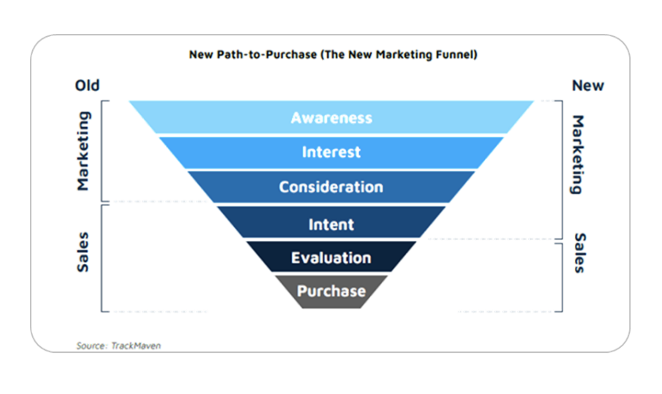
Let’s look at actionable things you can do to build trust with your digital experience.
Building trust with digital: personalization & UX
I find that many of our B2B clients feel overwhelmed when told to engage in “personalization”. There is actually a very accessible way to start thinking about personalization in B2B, but it requires that you stop equating “personalization” with “individualization”. There are actually levels of personalization that a digital team can act within: Macro Segmentation, Micro Segmentation, Individualization.

Every B2B business already knows their macro segmentation – customer type, customer size, customer location. At the macro segmentation level, you can consider personalization content, categories, catalogs and promotions. As you mature, you can look at micro segmentation, based on behaviors. At this level, consider personalized workflows, on-site messaging and promotions. It’s only at the top level that you need to worry about 1-to-1 relationships. At this level, consider product recommendations, search personalization, and notifications.
Personalization is tightly coupled with the overall user experience. And B2B buyers are becoming demanding about an excellent UX.

If your team is ready to focus on creating a more consumer-like experience but don’t know where to start, choose two or three of the categories below and borrow best practices from B2C to enhance them.
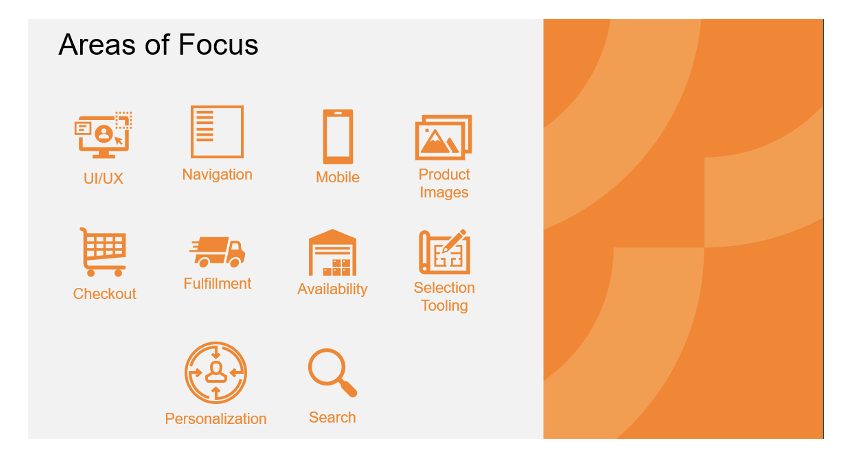
Building trust with digital: content and self-service
Having the right content is also critical to building trust with your digital customers. We all know that this includes accurate and complete product information. Consider alternative forms of content as well:

In addition to varied forms of content, ensuring that buyers can move through much of their buying experience in a self-serve manner is crucial. This is about providing the right information and the right tools at the right time. Start with good product data, spec sheets, order status, inventory, quick order, invoice payment, etc. If you want to go to the next level, consider these tools:
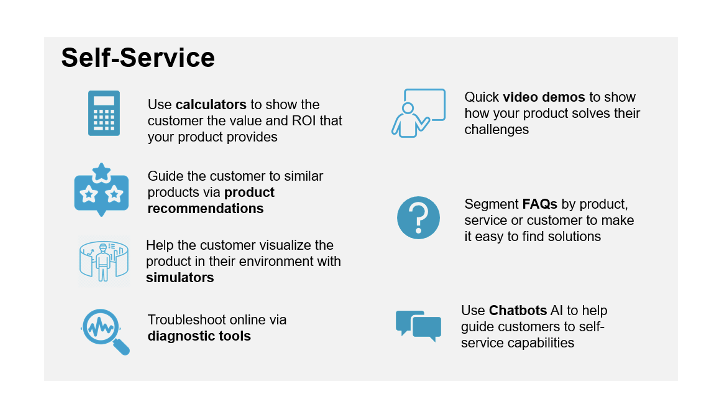
Building trust with digital: meet them where they are
The final advice we can impart is to truly build trust; you must meet the buyers wherever they are, not where you prefer. This includes:
- Social Media – B2B use of YouTube and Instagram have both grown more than 30% in a single year. Social media has finally reached the tipping point for B2B.
- Mobile – Mobile now influences 40% of all revenue for B2B organizations. It may not be your primary channel, but your buyers are leveraging their mobile devices as part of the process.
- Search – Millennials are twice more likely to discover products by searching online compared to older generations. With Millennials in the driver’s seat, search is becoming mission critical.
- Voice Assistants – 128 million people in the United States are now using voice assistants. It may not be primetime for B2B yet, but we anticipate this will be on the rise in the next couple years.
Take aways
- Millennials are becoming more deeply involved in the B2B buying decisions and want to interact with sales reps less and online more.
- COVID and generational impacts are driving online experiences to elevate to be more B2C-like experiences.
- Evaluate your organization and website and look for opportunities to build trust.
- Be personalized and relevant with communications and content. Look for opportunities to simplify the complex buying process and streamline the information overload many buyers are experiencing.
- Meet your customer where they are – through personalization and UX, content and self-service, social, mobile and search.
If you want to see all this data and more, you can still watch the webinar by visiting:



